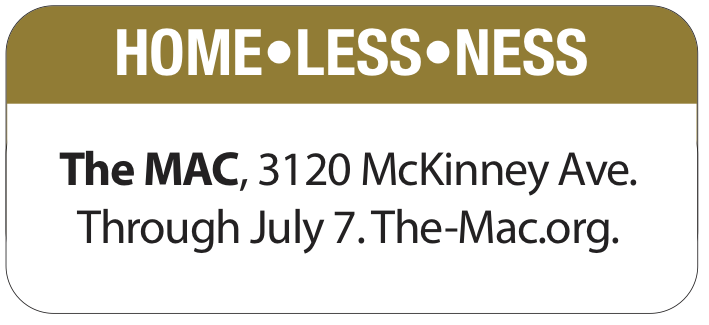Gay artist Robert Mateo Diago explores our collective discomfort with the homeless

A HOUSE IS NOT A HOME | Wooden blocks decoupaged with newsprint provide one of the metaphors of homelessness. (Photo courtesy R. Mateo Diago)
STEVEN LINDSEY | Contributing Writer
stevencraiglindsey@me.com
At some point or another, most of us have looked away when a homeless person approaches with an outstretched hand, or pretended not to notice them, even as they knock on our car window.
But for artist Robert Mateo Diago, it was important not to look away. He explores the variety of feelings evoked from the sight, even the concept, of homelessness in his show home•less•bound.
 The exhibit, at the MAC through July 7, expands a solo show he originally created in Massachusetts. The idea was hatched after attending a photography exhibit featuring images of a homeless man who’d been befriended by the photographer. Diago awoke later that night with visions of words: “Can You Spare Change? Can Change Spare You?” From there, he set out to use plays on words as a focal point in his exploration of new media.
The exhibit, at the MAC through July 7, expands a solo show he originally created in Massachusetts. The idea was hatched after attending a photography exhibit featuring images of a homeless man who’d been befriended by the photographer. Diago awoke later that night with visions of words: “Can You Spare Change? Can Change Spare You?” From there, he set out to use plays on words as a focal point in his exploration of new media.
“I didn’t want to show faces. I didn’t want to stylize beautiful black and white portraits. I wanted to do word play and get into what’s in your head about the homeless,” says the Puerto Rican-born artist.
Among the everyday items turned into dramatic statements are shopping carts, hubcaps, aluminum cans and an overturned Dumpster. Lenticular printing is utilized to transition a simple word like indigent into indifferent, depending on where the viewer is standing.
“I really wanted to explore the uncomfortableness, for lack of a better word, with the homeless,” Diago says.
To further develop his theme, Diago enlisted two other artists: Willie Baronet, who’s been purchasing will-work-for-food-type signs from the displaced for decades; and photographer Cristella Medrano, who focuses on the makeshift homes and meeting places created in vacant lots and underpasses. In combination, they explore very different sides of the homeless situation into one big statement.
One of the more interactive installations is titled 108 Affordable Green Homes. Scattered about the floor are tiny sculptures of homes, each containing a word underneath such as “bus”, “box” or “bench” that symbolizes “home” for so many. Most are constructed with newsprint applied in layers and painted onto their wooden bases, but some special-edition houses were created for Dallas with glossy pages of Paper City and other luxury publications to draw a starker contrast. Designed to sell separately from $100 to $150, they’re also a way for individuals to easily own an original work of art and take it away from the exhibit immediately.
“As the houses disappear, it’s a commentary on the lack of housing available to the homeless,” Diago explains.
Precious Apartment provides some of the more jarring attitudes toward the homeless. The process for this piece started with postcards that Diago gave out to friends, colleagues and others at random. People answered the question, “What are your thoughts about the homeless?” and mailed them to the MAC.
“I got responses ranging from ‘The homeless are Jesus incarnate on earth’ to ‘Fuck the homeless!’” Diago says. “I was amazed to read many people’s opinions. People are very passionate about it.”
An ex-girlfriend, a schoolteacher in Newark, gave them to her class of fourth-graders.
“A lot of them already had a very strong opinion about ‘lazy homeless people’ who are ‘too high to work.’ Where are they getting those ideas at that age?” Diago asks.
Set within an overturned trash receptacle is a digital photo frame that scrolls through 99 of the responses, along with nine joyous images of life, such as graduation and wedding pictures — pictures you’d normally see in a home, not here. When the responses from his survey are juxtaposed over these photos, it brings a new depth to the conversation. Try not to do a double take when a wedding photo appears with “Fuck the homeless” superimposed.
Ultimately, this exhibition gave Diago the means to interact more with homeless people and overcome his own discomfort with them.
“I drive around in the summer with bottled water in my car, and coats and sweaters in the winter. I’ve always done that, but it’s been hard to make eye contact. I’ve always been a little intimidated to do that,” he says. “Now I make a point to say hello, ask what their name is, and if I get a response from that then I ask more questions. I’ve had some really nice conversations.”
It’s a necessary reminder that homeless are all people with stories to share, if only anyone would ask.
This article appeared in the Dallas Voice print edition June 29, 2012.











Not all homeless are too lazy or high to work as the fourth grader suspects. You can read my story of how someone with a Masters degree (Harding University 1993) and no dependency issues can be made homeless with a search for “New police weapon against homeless” and “Historic coverup of FBI and police crimes currently taking place”. Bill Anderson soxin8@hotmail.com Abilene Christian University Class of 81